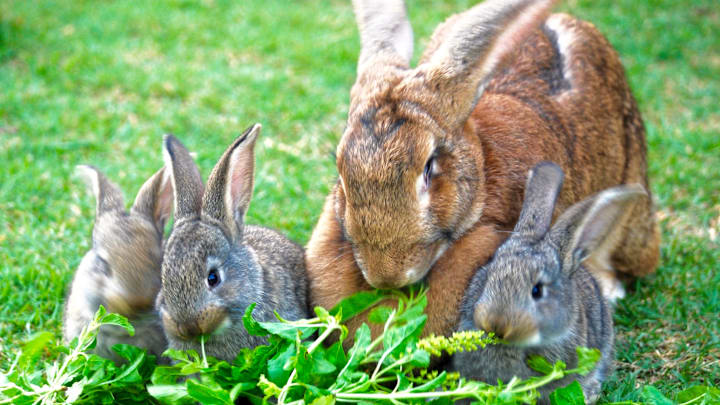When you think of a pet rabbit, you probably imagine the fluffy little bunny you got to take care of for a weekend during kindergarten—not one that’s the size of a small, carrot-eating toddler. But if you’re in the market for a pet that hops like a bunny yet steals food off the kitchen table like a puppy, then the Flemish giant rabbit is the one for you. Here are seven facts you should know about these special creatures.
1. They are the largest rabbit breed.
These rabbits are considered the largest breed in the world. On average, they weigh about 15 pounds and measure 2.5 feet long. However, the male Flemish giant can easily get up to 22 pounds and the female can get up to 20 pounds. One male Flemish giant named Darius actually set a world record, as he was a little over 4 feet long and tipped the scales at 49 pounds.
2. Males and females have different head shapes.
A male rabbit (a.k.a. a buck) has a broader head than a female (doe) does. The female rabbit has a dewlap—a large flap of skin under her chin—used to keep her offspring warm. While bucks can develop a dewlap as well, it is significantly more pronounced in females and can help set the rabbits apart.
3. They come in seven different colors.

The American Rabbit Breed Association (ARBA) officially recognizes seven different colors [PDF] for the breed: black, blue, fawn, light gray, steel gray, sandy, and white. In 1916, only those with light gray, steel, or black hues were recognized. Blues and whites were accepted in 1919, followed by sandy-shaded varieties in 1924, and fawns in 1938.
4. There’s a national federation that’s just for Flemish giant rabbit breeders.

The National Federation of Flemish Giant Rabbit Breeders (NFFGRB) was founded in 1915 by a group of four Flemish giant rabbit breeders. They host national shows where breeders are encouraged to show off their beloved bunnies. At shows, rabbits are posed in specific ways so judges can examine their bodies and teeth. To be eligible to compete, the rabbit must be one of the seven recognized colors and be entered into the correct age class, as outlined by ARBA.
5. They were originally bred for their fur and meat.
Flemish giants are known for their gentle demeanors: They’re generally regarded as docile and, as pets, they can even be trained to use a litter box. However, these furry bunnies were initially bred for other purposes—namely, for meat and fur. They can still be used for meat, but their large bone structure and expensive diet means you’re not getting much bang for your buck. Now, they’re mostly bred for show or as companions, due to their easy-going natures and lifespan (they can live to be 10 years old).
6. Flemish giants have big appetites.
Perhaps unsurprisingly, these big rabbits have impressive appetites to match. Fresh hay constitutes a significant part of their daily diets, with Timothy hay and/or alfalfa recommended by many experts. High-quality protein pellets can also be important to include in their diets, as are certain fruits and vegetables, like carrot tops, apples, bell peppers, and bananas (just in moderation, and always be sure to remove any seeds, pits, and/or stems). Flemish giants also need plenty of water daily.
7. Among historians, their origins are highly contested.

However, experts seem to agree that they were bred in 16th century Belgium. The first authentic record of their existence dates back to 1860, when Thomas Coatoam authored the Origins of the Flemish Giants. They made their first appearance in the U.S. in the 1890s, when they were brought over from England and Belgium.
A version of this article was originally published in 2016 and has been updated for 2023.
